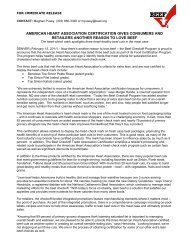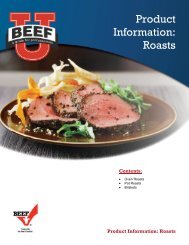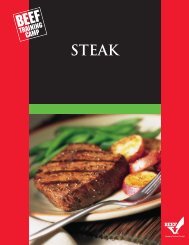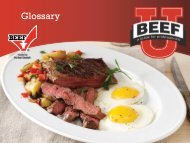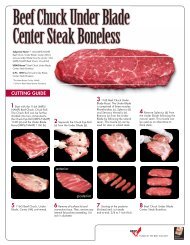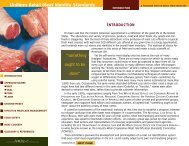Fact Sheet - Beef Foodservice
Fact Sheet - Beef Foodservice
Fact Sheet - Beef Foodservice
You also want an ePaper? Increase the reach of your titles
YUMPU automatically turns print PDFs into web optimized ePapers that Google loves.
While the color of raw muscle cuts may be aesthetically unacceptable to the eye of the<br />
consumer, the “dark-cutting” condition does not affect the eating quality of the cooked<br />
lean. Dark-cutting beef is considered acceptable for many foodservice applications,<br />
because the beef appears the same after cooking as “normal” colored beef, while it is<br />
not typically accepted at retail where shoppers would see the product uncooked.<br />
One caution in utilizing dark-cutting beef, however, is that it does not have a shelf-life as<br />
long as other beef when it is held fresh or thawed. Therefore, care should be taken to<br />
keep it chilled until ready for cooking, and storage time should be kept to a minimum.<br />
Meat Color<br />
The color of fresh meat is related to a specific protein in muscles called “myoglobin.”<br />
Myoglobin is a protein very similar to hemoglobin, the oxygen-carrying protein in blood.<br />
In fact, myoglobin serves as the protein in muscles that receives oxygen from the<br />
hemoglobin blood, and makes this oxygen available to the muscle tissues.<br />
Myoglobin and hemoglobin are very similar in that each is an iron-containing protein.<br />
However, hemoglobin has four times the iron content as myoglobin, which enhances its<br />
ability to transport oxygen in the blood throughout the body. The amount of myoglobin in<br />
the muscles of different animals is what gives various meats their distinctive fresh colors.<br />
<strong>Beef</strong> muscle that has not been exposed to air (oxygen) is a purplish red color. The<br />
foodservice operator or customer will recognize a color change with vacuum packaged<br />
beef cuts. In the vacuum bag the color appears to be purple-red. However, once it has<br />
been exposed to the air, the color brightens to a bright, cherry-red.<br />
In both cases, the myoglobin in the muscle picks up oxygen from the air (called<br />
“oxygenation”) resulting in the bright cherry-red color. This color change is often referred<br />
to as “bloom.” Other color changes can also occur to myoglobin in meat. For instance,<br />
when fresh meat is exposed to oxygen in the air for a longer period of time (perhaps<br />
several days) the surface may change to a “brownish” color. In this case, a chemical<br />
change (called “oxidation”) occurs to the myoglobin resulting in the brown surface color.<br />
Since these cuts may have been exposed for several days, they may also be susceptible<br />
to the onset of microbial spoilage.<br />
Another familiar color change that is associated with meat cookery is that Myoglobin,<br />
along with other proteins in meat, “denatures” when cooked. As the myoglobin gradually<br />
denatures with increasing temperatures, the red color progressively changes to a<br />
browner cooked meat color. The higher the internal temperature of the meat the less red<br />
the cooked meat becomes, reflecting the “degree of doneness” of the cooked meat.<br />
Iridescence in raw and cooked beef is a naturally occurring phenomenon that does not<br />
affect quality or palatability. It appears as a blue-green or orange-red color in some raw<br />
and cooked beef. It’s associated with the interference of light waves reflected off the<br />
meat’s surface. <strong>Fact</strong>ors such as the beef’s surface texture and color, and the type,<br />
wavelength and angle of the light affect the intensity of the iridescence. Smooth meat<br />
surfaces may exhibit iridescence more vividly than rough surfaces.





